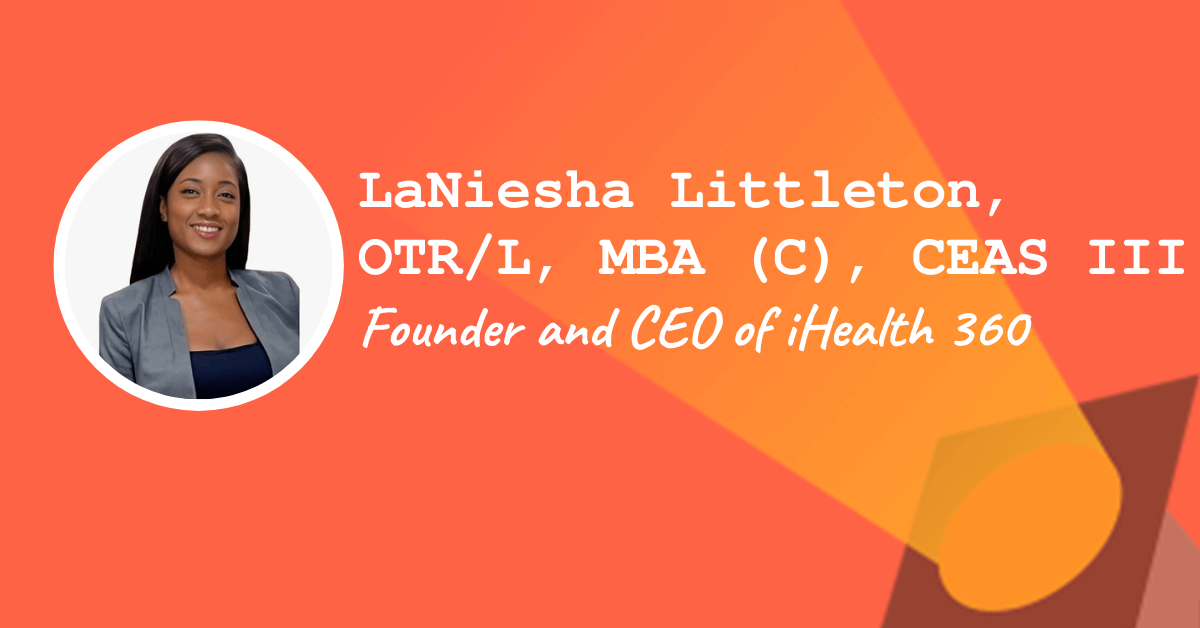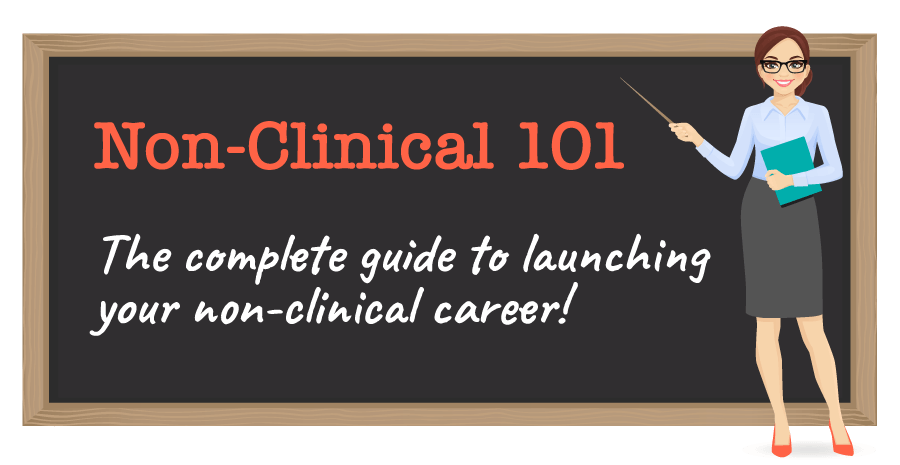This week’s spotlight is on LaNiesha Littleton, OTR/L, MBA (C), CEAS III, a non-clinical occupational therapist who is Founder and CEO of iHealth 360!
This post may contain affiliate links or codes. This won’t increase your cost, but it helps keep TNCPT alive, and free of annoying ads! Thank you for your support. 🙂
What is your full name, title, and company name for your current, primary role?
LaNiesha Littleton, OTR/L, MBA (C), CEAS III — Founder and CEO of iHealth 360, LLC

What additional roles do you currently have?
I am a second-year MBA student at Golden Gate University.
Where are you located?
San Mateo, CA.
Where did you go to OT school?
Please refrain from contacting our spotlight participants on social media. There are thousands of readers just like you out there. 🙂 Please ask your questions in the comments on this blog post.
If you’re a Non-Clinical 101 student, you can network with many of our spotlight participants in the alumni groups!
What did you do when you first finished school, and for how long?
After graduation, I studied for five consecutive weeks and completed the NBCOT national registration exam.
In what setting(s) did you work, and what types of patients did you treat?
I worked in outpatient hand and upper extremity rehabilitation, as well as in memory care and independent living facility settings.
What did you enjoy about your early roles? What didn’t you enjoy?
I enjoyed finally practicing in the field. Within two weeks of starting my first job, the clinic supervisor resigned.
This provided an opportunity for me to develop leadership skills extremely early in my career, as I was the main practicing clinician in this clinic.
What else have you done since then, prior to your current role?
For two years, I served as the Corporate Ergonomics, Worker’s Compensation, and Occupational Health program developer for a leading pharmaceutical company headquartered in California.
When and why did you decide to do something non-clinical?
I always knew that I wanted to be an entrepreneur. Leveraging my skills and background in healthcare helped me determine which path I wanted to travel.
While treating in the outpatient hand and upper extremity setting, it was common to see patients experience work-related musculoskeletal disorders, primarily associated with repetitive motion and overexertion type of jobs.
I quickly learned that occupational therapists have a unique opportunity to position ourselves on the side of prevention.
What are you doing these days?
At this time, I am currently building my business to be a pioneering firm in the workplace health and safety industry, helping employers to eliminate workplace musculoskeletal disorders and adopt preventative practices.
Are you still treating patients, or are you solely non-clinical?
I am not actively treating patients.
How long have you been in your current role as Founder and CEO?
I’ve been a business owner for over four years, but a full-time entrepreneur for almost one year!
What do you wish you would’ve known before going into this role?
I wish I would’ve known to continue to advocate for my value and worth as a transitioning occupational therapist.
Did you get any special certifications or training along the way to help you get into your current role?
Yes, Certified Ergonomics Assessment Specialist III.
How did you find your job? Did you apply or find it through a connection?
In a previous role, this job served as a first opportunity to grow in corporate health, after transitioning from direct patient care in 2021.
Essentially, a recruiter found me through LinkedIn. The message read something to the effect of: There is an opportunity in California to support the headquarters of a biotechnology company and to grow their ergonomics, workers compensation, and Occupational Health program. We believe your skillset and interest would align!
I was interviewed, offered a role, then relocated from Atlanta, GA to the San Francisco Bay Area.
Did you do anything special to your resume and cover letter to land the job?
I highlighted my ergonomic certifications and experience that related to IT ergonomics programming and interventions.
What was the interview like for the role?
I was interviewed by six members of the team.
When did you start your business?
April 2020.
Where did you get the idea for your business?
I knew I wanted to be an entrepreneur and also position myself on the side of injury prevention. Much literature exists surrounding ergonomics and how it impacts multiple industries.
My occupational therapy books have sections related to work rehabilitation and ergonomics. They always interested me!
What is your business, and what types of products or services do you offer?
iHEALTH 360 — comprising the largest network of ergonomic experts and musculoskeletal health providers — leverages industry leading technologies to protect employee health in the workplace, from hire to retire.
Founded in 2020, this woman and minority-owned enterprise helps employers hire more effectively, avoid workplace injuries, and get injured employees back to work safely and efficiently with our innovative solutions.
How have people reacted to you leaving patient care?
I remember colleagues always being surprised that opportunities existed, such as corporate ergonomics and national workers compensation program development. Roles related to ergonomics had been historically low in our profession in the southeast region. Over the past four years, I have seen many positions and incumbents while attending local conferences for our profession in ergonomics.
What’s a typical day or week in the life like for you? What types of tasks and responsibilities fill your time?
My job as Founder and CEO is to drive business growth, strategic partnerships, and lead a team to deliver cost-effective, comprehensive, and easily scalable solutions that confidently support employers anytime, anywhere.
What are some of the rewards of your role? What are the biggest challenges?
Ergonomics is somewhat of an altruistic field in that it allows for application of technical expertise but also problem-solving.
Ergonomic specialists are able to help prevent injuries, resolve discomfort, and boost overall productivity with their innovative solutions.
How did your clinical background prepare you for this role? Which skills transferred?
Ergonomics is about preventing musculoskeletal disorders. Having an occupational therapy background allowed me to:
- Learn anatomy and physiology
- Learn the pathology and progression of medical conditions
- Learn how to conduct assessments leveraging validated assessment tools
- Understand the patient/human body through a lifetime
- Comprehend the idea of a holistic approach
- Have visibility of different models, such as person, environment, and occupation (PEO)
This has all culminated into easily transferable skills to the profession of ergonomics and injury prevention.
Roughly speaking, how are the hours and pay compared to patient care?
Owning a business allows for the potential of passive income, so the ROI is different. For an ergonomics consultant or program manager, I believe the income is similar—and potentially higher—depending on if an individual is classified as part time, full time, or contractor.
Ready to explore all your non-clinical career options?
What type of person do you think would do well in your founder and CEO role?
Someone who would do well in my role has the following characteristics and skills:
- Interested in continuous learning and problem-solving
- Good analytical and technical skills
- Able to maintain privacy
- Reliable
- Good communication skills
- Knowledge of regulatory compliance and safety
Do you work remotely or onsite?
I work both remotely and onsite.
Does your organization hire PT, OT, or SLP professionals into non-clinical roles? If so, what type of roles?
Yes; Ergonomic Consultants, Injury Prevention Specialists, and Clinical Operations Directors.
Did you read any books, take any courses, or do anything special overall to get you where you are today?
The Rehabilitation of the Hand and Upper Extremity by Skirven, Chapter 138.
What is a typical career path for someone in your role?
Ergonomic consultants are commonly professionals with occupational or physical therapy backgrounds or human factor engineers. Careers typically exist within the environmental health and safety function as an ergonomics program manager. Furthermore, we can partake in sole consultant work.
What is next for you? What are your high-level career aspirations?
My goal right now is to continue to solidify my business and scale our operations.
What career advice would you give yourself that you wish you had during school?
I would first tell myself to not worry, and everything will work out how it’s supposed to.
Secondly, I would invite myself to learn about networking and business early on in my educational studies and career.
While we are excellent subject-matter experts, we as therapists must indulge ourselves in the business side of our passion and career as well!
What would you teach to today’s graduate students in your profession, if you had the opportunity?
I would teach them about a comprehensive, proactive approach to ergonomics and musculoskeletal disorder prevention.
Do you have any special advice for others who want to follow in your footsteps as a founder and CEO?
Read and research as much as you can about the field of ergonomics and how it applies to a variety of settings.
I’d also recommend learning about and leveraging certifications that support women, minorities, veterans, and small businesses.





